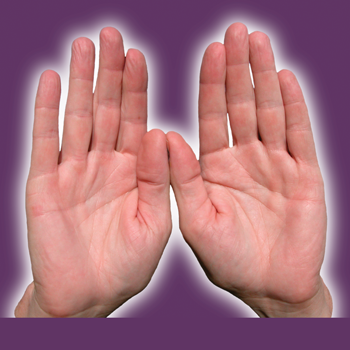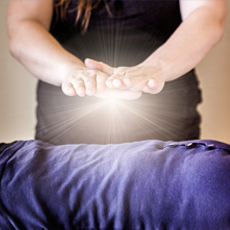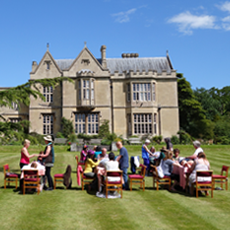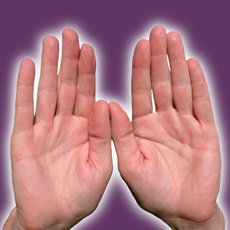by William Lee Rand
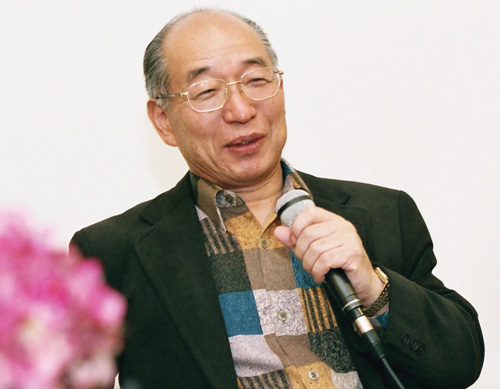 This article first appeared in the Spring 2014 issue of Reiki News Magazine.
This article first appeared in the Spring 2014 issue of Reiki News Magazine.
Overview
This is an important interview. A few of the topics covered by Doi Sensei include how Usui Sensei and the Gakkai teach Reiki. He also discusses the spiritual purpose Usui Sensei intended for Reiki and indicates that the Gakkai do not have a master symbol, just the 3 symbols of Reiki II.
Hiroshi Doi Sensei, a Gendai Ho Reiki Master who resides in Ashiya City, Japan, is a leading authority on the practice of Usui Reiki. His membership in the Usui Reiki Ryoho Gakkai places him in a unique position to access information about the style of Reiki developed and practiced by Usui Sensei. The Gakkai was the original organization started by Usui Sensei and the first four presidents of the organization through 1975 had received their Reiki training from him. Hiroshi Doi Sensei’s access to the Shinpi-den members of the Gakkai including the two most recent presidents along with access to Gakkai archives gives him an authentic source of information. His devotion to Reiki and to researching and preserving the historical facts of its practice make him a valuable resource to the Reiki community. He has also developed a system of Reiki called Gendai Reiki Ho and authored a book, Iyashino Gendai Reiki Ho, A Modern Reiki Method of Healing. This book was first published in Japan in 1998 and in Canada in 2000, but it has been out of print for almost 10 years. Now a revised version has recently been published. This interview will focus on this book and especially on the new information that has been included. This is the first part of a two part interview. The answers for this interview were translated from Japanese by Fumi Koji. (1)
WLR: The revised edition of Iyashino Gendai Reiki Ho, A Modern Reiki Method of Healing has additional information important to the practice of Reiki as well as an improved translation that makes it easier for English speaking people to understand the esoteric concepts you have expressed. Can you describe some of the additional information that the revised edition includes?
HDS: This book was revised in Japanese in March 2008, 10 years after the first edition. But this revised edition in English is not merely a translation of the original. The translator, who is a Gendai Reiki Master, gave it a thorough examination, and made suggestions to upgrade the information, which she confirmed with me. Then, we reviewed the important concepts with you, William, knowing that with your worldwide knowledge as a Reiki Master with over 20 years experience, you would be able to help us express the information in a form that would be more easily understood by the Western mind.
Through this more detailed editing process, the book has grown to better convey the facts about Usui Reiki Ryoho with its purpose of health and happiness and to better explain Gendai Reiki Ho, which is a more compatible system for 21st century people to live by.
The revised edition contains some information that I had not made available to the public before as it would have been considered too sensational at that earlier time. However, the time is now right for this information to be released. For instance, in the book you will now read explanations of the fact that Dento Reiki (the Reiki Usui Sensei taught) has neither a fourth symbol (Master Symbol) nor any Kotodama (mantras) and that some of the requirements of the Shinpi-den level students of Usui Sensei’s time have drastically changed since the time of the Gakkai’s second president.
In general, this book explains as easily as possible what has become clear to me in more than 20 years of practicing and teaching Reiki Ho. My translator, Fumi Koji and and you William, wonderfully made this happen by sorting and drawing precise points out of the huge stack of archives inside me.
WLR: In the revised edition you explain that the entire healing system of Usui Reiki was taught by Usui Sensei in the Sho-den and Oku-den levels and that occasionally some of the Oku-den students were taught how to give reiju (attunements) and offered this to students. Could you explain how this took place?
HDS: The whole course of Reiki healing is taught in Sho-den and Oku-den in the Gakkai. When a member is given Oku-den Koki (the second half of Oku-den), he/she is recognized as having completed the entire course of Usui Reiki healing. However, while the task of performing reiju is done by the Shihan (Shinpi-den title holder), some of those who were Oku-den Koki and in charge of local branches of the Gakkai were also taught reiju, and they offered this to the students of that branch. This took place only if the local branch didn’t have a Shihan. Today, the Shihan from the head office will visit the branch to give reiju when the branch chief is not a Shihan.
WLR: You have also explained that the Gakkai have only three symbols, which are the same three that are taught in Western Reiki Level II. The Gakkai do not have a master symbol and there is no special reiju or attunement for those who become Shinpi-den. Was this always the case and is there any awareness, understanding or use of the Master DKM symbol by the Gakkai?
HDS: The third symbol is a unique shape that contains five kanji characters whose overlapping parts are removed. The meaning of the five kanji characters is: “The basics to become happy start with the right consciousness.” This is the final symbol in the Gakkai’s teachings; they do not have the fourth one. I confirmed this by asking Koyama Sensei (the sixth president), Kondo Sensei (the seventh president) and other Shihans, and they all said they did not know it.
Reiju is the method to let the internal Reiki of the person get tuned into the Universal Reiki. There is only one kind of reiju in the Gakkai and in Gendai Reiki Ho. Reiju it is not a technique to give special abilities; its only purpose is to open the “pipe” of Reiki. So there is no reiju for the beginners, reiju for advanced learners or reiju for Shinpi-den.
Gendai Reiki Ho employs the three kanji characters of DKM as the fourth symbol in its curriculum (Level III) knowing that it is not a part of Dento Reiki. It is used in Gendai Reiki Ho because it generates a high resonance effect with the sacred vibration and connects one with the Universal consciousness and brings this Light to our consciousness.
WLR: Some have said that the original purpose of Usui Reiki was for spiritual development, but that Usui Sensei eventually changed its purpose into a system of healing. How accurate is this statement? Could you clarify what the original purpose of Usui Reiki was and how it developed from the beginning to the present as practiced by the Usui Reiki Ryoho Gakkai?
HDS: Some groups claim that 臼井霊気療法 Usui Reiki Ryoho was intended to cure disease, as the Japanese word 療法 “ryoho” literally means the curing therapy. If so, Usui Reiki Ryoho would have been just another one of the treatment therapies that existed before Usui Sensei. Usui Sensei said, “I have never studied any methods for disease treatment.” He also stated, “Usui Reiki Ryoho makes us fit and well, moderates our thought and enhances one’s joy of life.” and “Usui Reiki Ryoho heals Kokoro [mind and spirit] first, and then makes the body strong and healthy.” These statements of his clearly mean that he did not give first priority to curing disease. Usui Sensei wrote two descriptive statements that introduce 五戒 Go-kai The Five Precepts: 招福の秘法 “Shofuku no Hiho” “The secret method to invite happiness” and the second one, 萬病の霊薬 “Manbyo no Reiyaku” “The miraculous remedy/elixir for all diseases” that follows it. In this way he indicates that the ultimate goal of Usui Reiki Ryoho is to become happy and that we enter this happy state by becoming healthy through hand healing. Gendai Reiki Ho summarizes these two titles as one: “The way to health and happiness.” The point to remember is that Go-kai shows the same method for both happiness and health.
Usui Reiki Ryoho started from Usui Sensei’s quest for the purpose of life. Healing and spiritual development are both like wheels that run one car, Usui Reiki. The axle that connects the wheels is the resonance with Reiki. However, at a time when most people in Japan were too poor to see a doctor or to buy medicine even if they were seriously sick, it was rather difficult to preach to them that they should understand Anshin Ritsumei (the purpose of life). Considering this social circumstance, Usui Sensei awakened public interest by using the name of “Reiki Ryoho” (medical treatment by Reiki) because the generic use of the word reiki (not necessarily connected with Usui Sensei) for healing was becoming popular at that time. Then he taught spiritual development to those who reached a certain level. He never changed the purpose of Usui Reiki Ryoho over the course of time.
WLR: Please explain the special spiritual training Usui Sensei provided for those students who were ready for the Shinpi-den level. Can you explain what that training consisted of and how long this training lasted for each student?
HDS: Usui Sensei had no standard curriculum, and the length of time of the training depended on the spiritual progress of each student. It is said that he gave one-on-one lectures mainly on the right mental attitude needed for spiritual advancement based on his own experience. As it was personal, only fragmentary notes of his words written by his student have been found. The note says:
“Everything in the Universe possesses Reiki without any exception.” “We humans hold the Great Reiki that fills the Great Universe. The higher we raise the vibration of our own being, the stronger the Reiki we have inside will be.”“The Natural Law of the Great Universe and each human spirit as a small universe must be constantly united and exist as One.” “The Universe exists in me, and I exist in the Universe.” “ 光明 Komyo exists in me and I exist in 光明 Kyomyo.” [Komyo is the light of enlightenment.] “Everything in the universe is produced and developed by the magnificent Reiki that fills the Great Universe. Humans are a microcosm that takes the Great Spirit from macrocosm; everyone holds a part of this Great Reiki in his body. Therefore, we must always try to cultivate spirituality so that we can receive as much Great Reiki of the Universe as possible.”
“The training according to the Natural Law of this whole world develops human spirituality. When you are convinced of this Truth, your committed training brings about the unification with the Universe. The words you speak and the actions you take become one with the Universe and they effortlessly work as the absolute limitlessness. This is the true nature of being human.”
WLR: Can you give a more elaborate description of Anshin Ritsumei, the state of consciousness Usui Sensei received on Kurama Yama.
HDS: While experiencing a variety of occupations over the course of his life, Usui Sensei pondered the question as to whether there was a purpose of life and if there was, what was it. After a long quest, he came to the conclusion that the purpose of life was to become happy and happiness meant the attainment of the state of Anshin Ritsumei. He recognized Anshin Ritsumei as follows: “We humans are given life and a mission from the Universe. When it gives us life and a mission, it can never impose illness or misfortune on us. Regardless of what happens in life, we should trust the Universe and keep a peaceful mind state in order to accomplish our mission. This is the purpose and meaning of life.” Though he logically comprehended what it should be, he was often perturbed by anger or fear in actual life. To experience that perfectly peaceful mind state, he practiced Zen meditation at a temple in Kyoto for three years. But it did not give him the true experience. He thought that he would not deserve to live any more if he could not attain the meaning of life. So he climbed Mt. Kurama for meditation and fasting with the readiness to die. He gradually felt that the Reiki inside him and the Reiki surrounding Mt. Kurama were vibrating with each other and that the vibration became stronger day by day. At midnight of the 21st day, a thunder-like shock hit him on the top of his head, and he lost consciousness. Then in the pre-dawn hours, he woke up to find himself filled with an amazing refreshment he had never felt before. “I am the Universe, the Universe is me!”It was the actual feeling of his soul in perfect resonance. Finally he was in the mind state he had longed for. It is said that from then on, he always kept that peace in his mind.
As he came joyfully down from the mountain, he tripped over a tree root and broke the left big toenail. He instinctively put his hand on it and it was cured immediately. This was the first of many healing experiences that occurred unexpectedly. He soon understood that healing took place through the resonance between his inner Reiki and Reiki of the Universe. He also recognized that the Universe had given him a mission to invite many people to find Anshin Ritsumei, the purpose of life, by way of a particular kind of hand healing. He named the method 心身改善臼井霊気療法 Shinshin Kaizen Usui Reiki Ryoho and established the Usui Reiki Ryoho Gakkai in Tokyo to provide both healing and training sessions for the general public.
WLR: To what extent was Usui Sensei able to help the Shinpi-den students attain Anshin Ritsumei?
HDS: It seems that he tried to create a certain and quick system to foster spiritual development for more people as he knew he would pass on soon. Many of them are said to have reached or nearly reached Anshin Ritsumei by studying with Usui Sensei. But I think that he was not satisfied with the personal lecture system as it could guide very few people to the purpose of life, to Anshin Ritsumei. Personal lectures are not always a guarantee of transmitting knowledge: they can be an effective method only if taught by the right person in the right way; thus its results will vary according to the instructor’s competence and the student’s readiness. I think Usui Sensei thought that he should provide a certain system and showed Ushida Sensei how to carry it out, as he put his trust in him. The system Usui Sensei handed down simply advised that one must have the right recognition of basic consciousness, that one must repeatedly engrave it into the subconscious mind and that one must enhance its resonance with the Universe. For this purpose, what Usui Sensei taught was based on a healing practice in which the student should strive for the unification with the Universe through regular practice of Go-kai and Hatsurei-ho, through reading the Gyosei of Emperor Meiji and through attendance at Shuyo-kai.
WLR: I understand that this special training was discontinued after Usui Sensei passed. Can you explain why it wasn’t continued?
HDS: Usui Sensei’s special lecture greatly strengthened and enhanced many of the Shinpi-den practitioners’ spirituality. Furthermore, he seemed to try to create a certain and quick system to foster spiritual development for more numbers of people as he knew he didn’t have a lot of time left in this life. I think he mentored the Shinpi-den practitioners so that the training would contribute to the spiritual advancement not only for the Shinpi-den practitioners but also for the rest of the Gakkai members. If Usui Sensei had intended to lead just a small cadre of elites to Anshin Ritsumei, he would not have needed to give them the responsibilities of board member and instructor. The lecture provided only to Shinpi-den practitioners was discontinued after Usui Sensei passed. I think it is much more natural to understand that this decision came about because they acknowledged Usui Sensei’s intention that they must simply develop what they had learned with him.
WLR: You also explain that after Usui Sensei passed, the Gakkai offered no additional training for the Shinpi-den level—that it is honorary only, but does require those at this level to accept the responsibility of teaching others, managing the Gakkai and adding the finishing touch to the Oku-den practitioners healing treatments. It is also understood that those who are offered and accept the Shinpi-den level do not teach Reiki outside the Gakkai. Can you elaborate on the Shinpi-den level and give any additional details that may be important for us to know.
HDS: After Usui Sensei passed away, the Shinpi-den level changed and the healing practice became a method to directly encourage spiritual advancement. The main responsibility of the Shinpi-den today is to instruct the members as Shihan. They do not have to add the finishing touch to Okuden practitioners’ healing treatments as members of the Gakkai do not provide healing sessions to the general public any more. They only give them to the members and their families. Now that they do not provide training sessions for the general public, the activity of the Shinpi-den practitioners is limited to activities inside the Gakkai. When an organization decreases in number, the number of board members decreases as well. As a result, very few of them are serving as board members now. None of the Shinpi-den, the Sho-den or Oku-den practitioners speak freely about Reiki outside the Gakkai like I, an Oku-den member, do, so I appreciate that this is my mission.
The more important thing to understand about Shinpi-den is that even if Usui Sensei had been alive today, it would have been very few who were assigned to his one-on-one lecture. Though the personal lecture for spiritual advancement is not available, Reiki still is the ubiquitous energy of the Universe that is available to guide and develop us. When we have this broader point of view, we can see that Usui Sensei’s intention has been manifested; the system of spiritual learning that was reserved for Shinpi-den practitioners has only grown up to be available for everyone to receive its benefits. We also have to remember that we can get only what we have recognized. Although you may actually have a million dollars in your bag, if you believe you have just 500 dollars, you will be limited to making small purchases. If you believe Reiki cures only the body, “your Reiki” cures only the body. I think we should appreciate that Reiki is the energy of Love that guides us to Anshin Ritsumei and through the practice of Reiki healing we increase our trust in the Universe.
WLR: Gendai Reiki is a combination of Usui Reiki and Western Reiki and you have explained in your book that this is a style that is better suited for modern times. Could you please explain why it is better for modern times?
HDS: When we see the Reiki method as ”the way of health and happiness,” advantages and disadvantages of Western and Dento Reiki become clear to us. Western Reiki has had a focus on collecting medical evidence because its practitioners place priority on its healing effects. Dento Reiki, on the other hand, today considers the healing practice to be more on the level of home remedies and is not so interested in the scientific examination of its effects. The attitude of Western Reiki is validated by its historical background: Hayashi Sensei had developed the healing method according to his medical perspective and Takata Sensei first used Reiki to cure her diseases. She then learned Reiki from him and provided Reiki treatments into her later years at her clinic. Western Reiki had started from these two people. So it is quite natural that it emphasizes its use for healing treatments. But it seems that the importance of spiritual advancement, which is the basic philosophy of Usui Reiki Ryoho, was not exported to the West enough. When I spoke as a lecturer to introduce the true story of Usui Sensei and the contents of Dento Reiki at several workshops from 1999 in Vancouver to 2003 in Denmark, so many Reiki instructors wanted to know about the spiritual aspects. In that respect, Dento Reiki has a high level of spirituality regardless of whether the Gakkai members are aware of it or not.
Gendai Reiki Ho’s way of health starts from the basic 12 hand positions of Western Reiki. But it is not merely a copy of the Western method. We employ the healing method in a way that encourages the healer’s growth. Effective healing is important of course, but it must contribute to the spiritual development of the healer. Reiki healing heals both healer and healee at the same time. In the Go-kai, the way of happiness refers to the spiritual aspect of Reiki practice and in Gendai Reiki Ho this is developed by having as its purpose the creation of a greater resonance between one’s internal Reiki and Universal Reiki through the use of various methods. It will continue to develop its effectiveness to this end through the use of the motto: “Clear, practical and simple Reiki for daily use.” I believe the combination of the healing aspect with the spiritual aspect is one of the biggest features of Gendai Reiki Ho.
This article first appeared in the Spring 2014 issue of Reiki News Magazine.
Interview With Hiroshi Doi Sensei (2014) – Part II
by William Lee Rand
This article first appeared in the Winter 2014 issue of Reiki News Magazine.
WLR: What is the most important part of the Usui Reiki training?
HDS: After the first Reiju opens the Reiki “circuit” inside, we Reiki practitioners must strive to cleanse it to raise the quality and quantity of the energy that flows in the circuit. Also we must always keep the Kokoro (spirit or heart) in peace, being careful not to mix in negative energies, such as anger or fear.
The Usui Reiki Ryoho Gakkai puts special emphasis on the above, explaining in their terms: “To develop the pipe of Reiki.” For this purpose, the Gakkai encourages its members to attend 修養会 Shuyo-kai, now called 研究会 Kenkyu-kai (class), to receive Reiju as many times as possible, to exercise Hatsurei-ho (the exercise to accelerate Reiki flow), to consider the Gyosei (waka poems) of Emperor Meiji as food for Kokoro and to uphold Go-kai (the Five Reiki Principles).
Gendai Reiki Ho explains it this way: “To enhance the resonance of inner Reiki with the Universal Reiki.” The practice of healing allows us to develop the pipe of Reiki, and it raises the purity of Reiki within us. The purer internal Reiki we have, the more resonance with the Universe we have. In this way, we get close to the complete oneness with the Universe. I believe this is the most important factor of Reiki practice.
WLR: What is the most important technique or skill to develop in Usui Reiki?
HDS: In 伝統霊気 Dento Reiki (based on the teachings of the Usui Reiki Ryo-ho Gakkai), after one has the Reiki circuit open and also continues to strive to raise the quantity and quality of the Reiki energy one is able to channel, it is important to learn how to use the Reiki energy. The most important skill in this respect is knowing where to place one’s hands so one can provide an effective Reiki session. 病霊感法 Byosen Reikan-ho and 霊示法 Reiji-ho are the skills used to do this and are taught by the Gakkai on the first day of training. They are taught first because they are the most important and also because they take the most time in which to develop adequate skill.
Byosen is the negative energy that comes from an illness or area of distress in the client. It is detected by using the sensitivity in the hands. With ones hands in gassho one says prayers of gratitude for the healing that is about to take place and asks to be shown those areas in need of healing. Then the practitioner slowly moves the palm of the hand above the body of the client while paying attention to the sensations on the palm of the hand. When the practitioner detects a Hibiki (disturbance) on the palm of the hand, which is caused by byosen, the practitioner will begin to treat the area with Reiki. Reiji-ho uses one’s Reiki guided intuition to know where to place the hands. It is done by placing ones hands into gassho and saying prayers of gratitude for the healing that is about to take place, and then asking to be directly shown where to place one’s hands intuitively. This knowledge then enters the mind and the practitioner follows this guidance and places the hand on or over the area to be treated.
WLR: In the Gakkai, what is the usual length of time that a student takes to complete Sho-den and each of the levels of Oku-den?
HDS: It took me 10 years to complete as I was too busy at that time to attend Kenkyu-kai very often. There is no standard time duration since how long it takes depends on the development of a person’s healing ability. The Gakkai says that some take only five years and some take more than 20 years. There were 21 who were learning Shinpi-den from Usui Sensei at the time of his passing. As Usui Sensei lived for only four years after he started the Gakkai, it is assumed that his students might have taken about two or three years to learn Sho-den, Oku-den Zenki and Oku-den Koki. Compared with those outstandingly advanced people, it is reasonable that general practitioners now need more time.
WLR: How do the Shinpi-den teachers determine when a student has completed the Usui Reiki training and is ready to receive his or her certificate?
HDS: Which Shihan instructs a class changes depending on the day, and the students can choose freely whose training to take. All the Shihans know the ability of the students who earnestly choose to come to Kenkyu-kai and training sessions. The student’s ability is carefully checked when he or she is willing to go on from Sho-den to Oku-den level. 師範会 Shihan-kai, a meeting attended by Shihans only, is held several times a year to discuss the competence of the student(s). The Shihans must all be in agreement in order to declare that a student has completed the training. It is voted down even if only one Shihan disagrees. If they all agree on the choice of a particular student, they issue the certificate, which is signed by the president.
WLR: Did Usui Sensei include any additional training for the use of Reiki as a healing method in the Shinpi-den level or was the content only about spiritual development?
HDS: When a member finishes Oku-den Koki, the Gakkai issues a certificate that acknowledges that he/she has completely fulfilled the healing ability requirements of Usui Reiki Ryoho. There was even a time when the Gakkai issued the equivalent of a special certificate to be able to charge for healing sessions.
Usui Sensei did not give additional healing trainings but I heard that he often taught classes about a Shihan’s mental attitude in order to improve one’s teaching methods when teaching about healing to the members. Though his one-on-one Shinpi-den lecture did not include healing training, I also heard that Usui Sensei’s mentorship greatly enhanced the healing ability of many of the Shinpi-den practitioners, as it strengthened their resonance with the Universe and encouraged the awareness that a human is the small universe derived from the Great Universe.
WLR: You mention that you developed Gendai Reiki as a system of healing for your own personal use and then when people commented on how much healthier you looked you decided to teach it to others. Could please you comment on how this developed?
HDS: I am familiar with 座禅 Zazen (seated Zen meditation) and therefore even early on, the invisible world was quite natural for me to understand. After finishing school, I worked for a national telephone company and moved to one of the biggest automobile companies after 12 years. And after that I changed jobs often. I was very short-tempered when I was young. When things did not turn out to be what I had expected, I became furious and at the same time I was disturbed by fear. I was on a roller coaster ride of emotion. I even lost a chance to join a company that had just accepted me under advantageous conditions as I had a tussle with the new boss at the welcome party for me.
At a certain point in my life, I became interested in healing because my best friend was suffering from an incurable disease. I learned more than 30 types of healing methods and one of them was Reiki. I first learned Western Reiki, and had a gut feeling that this was what I had wanted to find. People said that the traditional Usui Reiki Ryoho and the Gakkai were gone. But I knew otherwise, since I happened to know of the existence of the Gakkai. I joined them through an old member. In October 1993, the sixth president, Kimiko Koyama Sensei, gave me my first Reiju at the Kyoto branch, and I could not stop the tears that came because of a kind of homecoming feeling that went through me. As I continued to practice Reiki, I realized that a peaceful mind state was gradually returning, and I expected that my episodes of short-temper would soon lessen. Around this time, valuable information of Usui Sensei’s times came to me quite naturally through conversations with my acquaintances. I sorted this information out to construct an effective and practical Reiki system to continue to improve myself. Gendai means modern; Gendai Reiki Ho is the way to practice Reiki for modern people. I have kept developing it to be a more effective system according to my studies and trials. I developed Gendai Reiki Ho in order to improve myself, and my short temper completely disappeared without my even realizing it. Then people who noticed my change asked me to teach them. In this way, it has become popular quite naturally.
WLR: In Gendai Reiki the Reiju or attunements are not the same as that given by Usui Sensei or the Gakkai. Please explain how you developed this attunement method and why you chose to do so.
HDS: Gendai Reiki Ho’s attunements are based on Neo Reiki in the lineage of Osho Reiki, which included fairly accurate information about Dento Reiki. I think its attunement method is simpler and more effective than any other of the Reiki methods.
Gendai-Reiju is an original Reiju method that quickly attunes one to the Reiki wavelength. It is a different method from that of Dento Reiki today. Around the time of the Gakkai’s establishment, Usui Sensei, using his wisdom and ingenuity, modified the Reiju methods many times to make them more effective. Gendai-Reiju is based on one of the earlier methods he developed.
WLR: In your Gendai Reiki Master Reiju you use the Master DKM symbol, even though it isn’t used by the Gakkai nor was it used in Dento Reiki. Could you please explain why you have chosen to do this and the value of doing so.
HDS: The Gendai Reiki Ho Master attunement integrates all four symbols to produce a new Reiki Master. Most Western Reiki schools attune students to the three symbols in the second level and the fourth symbol in the third or Master level. I refer to this as “setting” the symbols in the practitioner’s energy body. Those symbols can sometimes be set without balancing each other. When the four symbols are set properly, the practitioner can use each one without any trouble. But when some of these symbols do not balance each other, the effect isn’t as great as could be expected from their combined use. I know from my experience that about 60% of Master students have the four symbols in good balance. In these cases, the Gendai Reiki Ho Master attunement has no effect one way or the other. However, in the case of the other 40%, when the four symbols are not balanced amongst themselves, this attunement provides that balance, and it will remain permanently. The purpose of this integrating attunement is to produce a new Master with balance among the four symbols.
WLR: What do you see as the future of your work with Reiki?
HDS: I will turn 80 November 2, 2015, so I am not going out of my way to advertise my seminar; however I am pleased to continue to support Reiki practitioners while I still have my health and my mission. My main activity is to be advisory support for the Gendai Reiki Network (GRN), which is a non-profit organization that is managed voluntarily by a group of Gendai Reiki practitioners, my fellow classmates of Light. The GRN provides all of us with opportunities to teach and learn from each other as well as to promote Reiki in the right way. GRN offers free healing sessions and hosts Koryu-kai that anyone can attend in major cities throughout Japan. It also organizes a Reiki retreat and 研鑽会 Kensan-kai (study meeting) and works cooperatively with a physician in studying medical evidence of Reiki treatments.
The international network of Gendai Reiki has been sprouting up in many countries, growing with the GRN to exchange deep friendships. This movement has increased since the five-day event in Kyoto on March 2012, with many Gendai Reiki practitioners attending from abroad. In March 2014, we had 交流会 Koryu-kai (gathering/sharing) in Kyoto with Spanish- and English-speaking practitioners. When foreign practitioners visit Japan to join the GRN events, I arrange the Master Special Course to help them develop a clear understanding of Reiki. I expect to have more chances to bring foreign practitioners to Japan to share in new friendships and exchanges with Japanese practitioners.
1 A previous 2 part interview appeared in this magazine in 2003. “An Interview with Hiroshi Doi,” Reiki News Magazine, Pts. 1 and 2 (Summer 2003): 9–11; (Fall 2003).
This article first appeared in the Winter 2014 issue of Reiki News Magazine.


